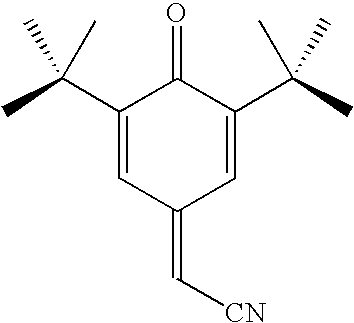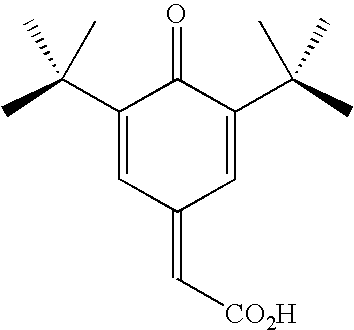Polymer inhibition of vinyl aromatic monomers using a quinone methide/alkyl hydroxylamine combination
a technology of quinone methide and alkyl hydroxylamine, which is applied in the direction of organic chemistry, thickeners, other chemical processes, etc., can solve the problems of undesirable polymerization of many of these monomers, loss of production efficiency, and particularly problematic undesired polymerization reactions, so as to inhibit the premature polymerization of vinyl aromatic monomers
- Summary
- Abstract
- Description
- Claims
- Application Information
AI Technical Summary
Benefits of technology
Problems solved by technology
Method used
Image
Examples
example 1
[0027]In a first example a comparison was made between a sample of a prior art retarder-inhibitor combination comprising HPHA inhibitor and DNBP retarder and a sample of the inventive retarder-inhibitor combination comprising a 7-substituted-quinone methide retarder and an HPHA inhibitor. The retarders were added to each sample at a dosage of 350 ppm relative to monomer weight and the inhibitor was added at a dosage of 150 ppm relative to monomer weight in a continuous stirred tank reactor. The two samples were heated to 120 degrees Celsius and underwent a 1-hour residence. The prior art sample resulted in 539 ppm of unwanted polymer while the inventive retarder-inhibitor combination only had 38.5 ppm of unwanted polymer. This demonstrates that not only is the inventive retarder-inhibitor combination capable of matching the performance of the prior art combination without the toxicity, it in fact has unexpected vastly superior performance.
example 2
[0028]In a second example a comparison was made between a sample a prior art retarder-inhibitor combination comprising HPHA inhibitor and DNBP retarder and a sample of the inventive retarder-inhibitor combination comprising a 7-substituted-quinone methide retarder and an HPHA inhibitor. The retarders were added to each sample at a dosage of 350 ppm relative to monomer weight and the inhibitor was added at a dosage of 22.5 ppm relative to monomer weight in a continuous stirred tank reactor.
[0029]The two samples were heated to 120 degrees Celsius and underwent a 1-hour residence. The prior art sample resulted in 573 ppm of unwanted polymer while the inventive retarder-inhibitor combination only had 62 ppm of unwanted polymer. This demonstrates that the inventive retarder-inhibitor combination is even capable of drastically preventing the production of unwanted polymer under emergency conditions where additional inhibitor cannot be added.
PUM
| Property | Measurement | Unit |
|---|---|---|
| temperature | aaaaa | aaaaa |
| temperature | aaaaa | aaaaa |
| temperatures | aaaaa | aaaaa |
Abstract
Description
Claims
Application Information
 Login to View More
Login to View More - R&D
- Intellectual Property
- Life Sciences
- Materials
- Tech Scout
- Unparalleled Data Quality
- Higher Quality Content
- 60% Fewer Hallucinations
Browse by: Latest US Patents, China's latest patents, Technical Efficacy Thesaurus, Application Domain, Technology Topic, Popular Technical Reports.
© 2025 PatSnap. All rights reserved.Legal|Privacy policy|Modern Slavery Act Transparency Statement|Sitemap|About US| Contact US: help@patsnap.com



